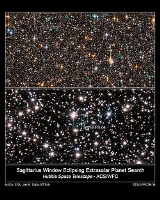
SWEEPS-04
Encyclopedia
SWEEPS-04 is an extrasolar planet
orbiting the star
SWEEPS J175853.92−291120.6 in the constellation
Sagittarius
approximately 22000 ly away (based on a distance modulus
of 14.1) from the Solar System
. This planet was found in 2006 by the Sagittarius Window Eclipsing Extrasolar Planet Search
(SWEEPS) program that uses transit method.
The upper limit on the planet's mass is 3.8 times the mass of Jupiter
. The best fit radius is 0.81 times that of Jupiter, but the uncertainty in this value is large, around 12%. It orbits at an average distance of 8,200,000 km (0.055 AU) from the parent star, taking 4.2 days to revolve around it.
Extrasolar planet
An extrasolar planet, or exoplanet, is a planet outside the Solar System. A total of such planets have been identified as of . It is now known that a substantial fraction of stars have planets, including perhaps half of all Sun-like stars...
orbiting the star
Star
A star is a massive, luminous sphere of plasma held together by gravity. At the end of its lifetime, a star can also contain a proportion of degenerate matter. The nearest star to Earth is the Sun, which is the source of most of the energy on Earth...
SWEEPS J175853.92−291120.6 in the constellation
Constellation
In modern astronomy, a constellation is an internationally defined area of the celestial sphere. These areas are grouped around asterisms, patterns formed by prominent stars within apparent proximity to one another on Earth's night sky....
Sagittarius
Sagittarius (constellation)
Sagittarius is a constellation of the zodiac, the one containing the galactic center. Its name is Latin for the archer, and its symbol is , a stylized arrow. Sagittarius is commonly represented as a centaur drawing a bow...
approximately 22000 ly away (based on a distance modulus
Distance modulus
-Definition:The distance modulus \mu=m-M is the difference between the apparent magnitude m and the absolute magnitude M of an astronomical object...
of 14.1) from the Solar System
Solar System
The Solar System consists of the Sun and the astronomical objects gravitationally bound in orbit around it, all of which formed from the collapse of a giant molecular cloud approximately 4.6 billion years ago. The vast majority of the system's mass is in the Sun...
. This planet was found in 2006 by the Sagittarius Window Eclipsing Extrasolar Planet Search
Sagittarius Window Eclipsing Extrasolar Planet Search
The Sagittarius Window Eclipsing Extrasolar Planet Search, or SWEEPS, was a 2006 astronomical survey project using the Hubble Space Telescope's Advanced Camera for Surveys - Wide Field Channel to monitor 180,000 stars for seven days to detect extrasolar planets via the transit method.-Area...
(SWEEPS) program that uses transit method.
The upper limit on the planet's mass is 3.8 times the mass of Jupiter
Jupiter
Jupiter is the fifth planet from the Sun and the largest planet within the Solar System. It is a gas giant with mass one-thousandth that of the Sun but is two and a half times the mass of all the other planets in our Solar System combined. Jupiter is classified as a gas giant along with Saturn,...
. The best fit radius is 0.81 times that of Jupiter, but the uncertainty in this value is large, around 12%. It orbits at an average distance of 8,200,000 km (0.055 AU) from the parent star, taking 4.2 days to revolve around it.
See also
- Sagittarius Window Eclipsing Extrasolar Planet SearchSagittarius Window Eclipsing Extrasolar Planet SearchThe Sagittarius Window Eclipsing Extrasolar Planet Search, or SWEEPS, was a 2006 astronomical survey project using the Hubble Space Telescope's Advanced Camera for Surveys - Wide Field Channel to monitor 180,000 stars for seven days to detect extrasolar planets via the transit method.-Area...
or SWEEPS - SWEEPS-10SWEEPS-10|- style="vertical-align: top;"SWEEPS-10 is, as of June 2007, the planet candidate with the shortest orbital period yet found. The planet orbits the star SWEEPS J175902.00−291323.7 located in the Galactic bulge at a distance of approximately 22000 light years from Earth...
- SWEEPS-11SWEEPS-11SWEEPS-11 is an extrasolar planet orbiting the star SWEEPS J175902.67−291153.5 in the constellation Sagittarius approximately 22000 light years away from the Solar System...
- List of extrasolar planets

